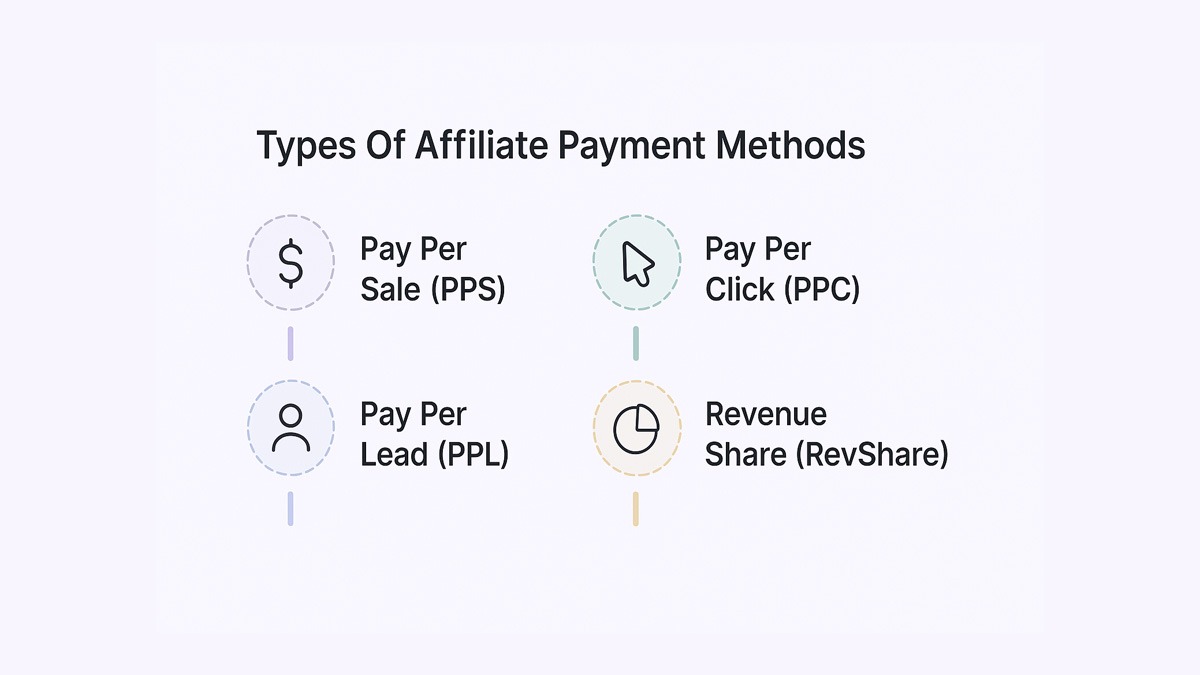

Affiliate Payment Methods: Types, Solutions & How They Work

Affiliate Payment Methods: Types, Solutions & How They Work
Explore affiliate payment types and solutions to streamline payouts, improve accuracy, and scale your affiliate program globally.


When you click on an influencer’s link and buy something, you’re not just shopping - you’re triggering an entire payment chain that quietly powers the affiliate economy. Behind every click and commission is a finely tuned system of payouts, tracking, and compliance that keeps brands and affiliates aligned. As affiliate marketing grows past $17 billion globally, choosing the right affiliate payment methods isn’t just a technical decision - it’s a competitive advantage.
What this blog covers:
- What are affiliate payments?
- Why are affiliate payments important?
- Types of affiliate payment methods
- Best affiliate payment solutions
- How affiliate payments work
- Making payouts to affiliates smoothly
- How Spendflo helps with affiliate payment optimization
- Frequently asked questions on affiliate payments
What Are Affiliate Payments?
Affiliate payments refer to the commissions brands pay their affiliates for driving sales, leads, or clicks through unique tracking links. These payments can be structured in different ways - per sale, per click, or as a revenue share - and are often managed through automated platforms. In short, affiliate payments keep the partnership between advertisers and affiliates running smoothly and transparently.
Why Are Affiliate Payments Important?
Affiliate payments aren’t just about money - they’re a key part of building strong, lasting partnerships. When done right, they improve program performance, reduce friction, and help brands scale efficiently. Here’s why they matter:
Builds Affiliate Trust
Timely, accurate payments show affiliates that the brand values their effort. This trust keeps top performers loyal and motivated to keep promoting your products.
Reduces Partner Churn
Payment delays or errors are one of the top reasons affiliates leave a program. A consistent payout process encourages long-term engagement.
Supports Global Reach
As affiliate networks expand worldwide, a well-structured payment system ensures smooth payouts across different currencies, countries, and compliance rules.
Minimizes Manual Errors
Automating affiliate payments reduces the risk of duplicate payouts, missed commissions, or calculation mistakes - saving time and avoiding disputes.
Enables Scalable Growth
As programs grow, manual processes break. Scalable payment systems help handle hundreds or even thousands of affiliates without increasing overhead.
Types Of Affiliate Payment Methods
Affiliate programs can follow different payout models depending on their goals - whether it's driving sales, generating leads, or simply getting more eyeballs. Here are the most common affiliate payment methods:

Pay Per Sale (PPS)
Affiliates earn a commission when someone makes a purchase through their referral link. This is the most widely used model and ties payouts directly to revenue, making it low-risk for brands.
Pay Per Click (PPC)
In this model, affiliates are paid for every click they drive to a brand’s site, regardless of whether a sale happens. It’s ideal for boosting visibility and traffic but requires careful tracking to ensure quality clicks.
Pay Per Lead (PPL)
Affiliates get paid when they generate a qualified lead - such as a newsletter sign-up or demo request. This works well for companies with longer sales cycles or service-based businesses.
Revenue Share (RevShare)
Affiliates earn a percentage of the revenue they help generate, often on a recurring basis. This model works best when customer lifetime value is high, such as in subscription businesses. This is common in SaaS or subscription businesses and encourages long-term promotion.
Each model offers a different balance of risk and reward, both for brands and affiliates.
Best Affiliate Payment Solutions
Choosing the right affiliate payment solution can be the difference between a smooth, scalable program and a partner experience filled with friction. Below are four top-rated affiliate payout platforms that simplify global payments, streamline compliance, and keep your affiliates coming back.
Tipalti
Tipalti is a global payment automation platform designed for scaling businesses. It supports payouts in over 120 currencies and 190 countries via multiple methods including ACH, wire, PayPal, and prepaid debit cards. Its built-in compliance features - like tax form collection (W-9, W-8BEN), OFAC screening, and VAT validation - make it a favorite for finance teams in high-growth companies. Seamless ERP integrations ensure accurate reporting and reduced manual work.
About the Company: Type: Private | Year Founded: 2010 | Website: www.tipalti.com | Head Office Location: San Mateo, California | Number of Employees: 900+
Best for: Mid-to-large businesses managing global affiliate payouts at scale.
Key Features:
- Supports multi-currency, multi-method payments
- Built-in tax and regulatory compliance tools
- Automated payment reconciliation and reporting
- Integration with ERP tools like NetSuite, QuickBooks, and Xero
PartnerStack
PartnerStack is an affiliate and partner relationship platform built specifically for SaaS and B2B companies. It automates everything from partner onboarding to commission payouts, offering real-time tracking and customizable commission structures. PartnerStack also includes a marketplace that helps brands connect with new potential affiliates.
About the Company: Type: Private | Year Founded: 2015 | Website: www.partnerstack.com | Head Office Location: Toronto, Canada | Number of Employees: 250+
Best for: SaaS companies running performance-driven partner programs.
Key Features:
- Automated commissions payouts and partner tracking
- Partner onboarding, segmentation, and performance analytics
- Tiered and recurring commission support
- Affiliate discovery through built-in marketplace
Trolley (formerly Payment Rails)
Trolley is a global payouts platform designed for creators, freelancers, and affiliates. It offers a branded payment experience and handles the full compliance stack - including KYC, tax reporting, and currency conversion. With real-time payment updates and easy payout options, Trolley improves trust and transparency for partners.
About the Company: Type: Private | Year Founded: 2015 | Website: www.trolley.com | Head Office Location: Montreal, Canada | Number of Employees: 100+
Best for: Affiliate programs targeting global influencers, creators, and freelancers.
Key Features:
- Global payouts in 200+ countries and 40+ currencies
- Custom-branded payment experiences
- Built-in KYC and tax compliance
- Real-time payment tracking and history
Impact.com
Impact.com is an end-to-end partnership management platform that supports everything from affiliate contracting and tracking to automated payments. It’s designed for companies that work with a wide variety of partners, including influencers, affiliates, and media houses. With flexible commission models and in-depth reporting, it gives brands full control over complex programs.
About the Company: Type: Private | Year Founded: 2008 | Website: www.impact.com | Head Office Location: Santa Barbara, California | Number of Employees: 1000+
Best for: Enterprises with diverse partnership strategies and high customization needs.
Key Features:
- Flexible commission rules and custom partner contracts
- Affiliate tracking, onboarding, and analytics in one platform
- Automated global payments and invoicing
- Scheduled mass payouts to affiliates across regions
- Integration with eCommerce, CRM, and ad platforms
How Affiliate Payments Work
Affiliate payments follow a structured process - one that ensures commissions are accurate, timely, and tied to real performance. Here’s how it typically works:

Set Clear Payment Terms
Brands define how affiliates will be paid - including commission rates, payout thresholds, and payment schedules. These terms are usually agreed upon during onboarding. Most brands provide an affiliate portal where partners can view their earnings and track performance.
Track Conversions
Affiliates promote products using unique links or codes. These often lead to a targeted landing page designed to convert visitors into customers. When someone clicks and completes a desired action (like a purchase or signup), the activity is tracked and logged by the affiliate platform. Modern affiliate programs rely heavily on accurate tracking software to ensure fair attribution.
Validate Earnings
Before payment is issued, the brand confirms that the action qualifies for commission - ensuring it wasn’t canceled, refunded, or fraudulent.
Calculate Payouts
Once approved, the system calculates how much each affiliate is owed based on the agreed model (e.g., per sale or revenue share).
Disburse Payments
After the validation window closes, payments are automatically processed through the affiliate’s preferred method - whether that’s PayPal, bank transfer, or another platform. Choosing the right payment processor can make a big difference in payout speed and reliability. Many affiliates prefer receiving earnings through direct deposit for speed and convenience.
This system keeps the process transparent, efficient, and fair for all parties. Some advanced programs are beginning to explore blockchain technology to enhance payout traceability.
Making Payouts To Affiliates Smoothly
A smooth payout process keeps affiliates happy and loyal. Start by automating payments to eliminate delays and reduce human error. Affiliates promote across various digital channels, from blogs to social media. Support multiple currencies and payment methods to accommodate a global partner base. U.S.-based affiliates often prefer ACH transfers for their low fees and reliability. Collect tax forms upfront to stay compliant and avoid last-minute issues. Most importantly, communicate clearly - letting affiliates know when and how they’ll be paid builds trust and transparency. A reliable system turns payment from a task into a growth driver.
How Spendflo Helps With Affiliate Payment Optimization
Spendflo helps streamline and optimize affiliate payment operations by bringing all payouts, contracts, and tools into one centralized platform. This eliminates the need for error-prone manual payouts and disjointed tools. It eliminates manual errors, automates approvals, and provides clear visibility into recurring affiliate costs. Teams can track payment schedules, monitor contract terms, and stay compliant - all without juggling spreadsheets or chasing approvals. Digital contracts help streamline the affiliate onboarding and agreement process. With Spendflo, finance and procurement teams can confidently scale affiliate programs while maintaining control and reducing overhead. The platform also supports mass payments to streamline payouts across large affiliate networks.
Frequently Asked Questions on Affiliate Payments
What are the most common affiliate payment models?
The most popular models include Pay Per Sale (PPS), Pay Per Lead (PPL), Pay Per Click (PPC), and Revenue Share (RevShare). Each caters to different goals - from driving conversions to increasing brand awareness or recurring revenue. One common performance metric is Cost Per Click, especially in traffic-driven campaigns.
How often should affiliates be paid?
Monthly payouts are the standard, but some programs offer bi-weekly or even weekly payments for high-performing affiliates. The key is setting clear expectations and sticking to a predictable schedule.
What tools help manage affiliate payments effectively?
Popular tools like Tipalti, Trolley, PartnerStack, and Impact.com help automate affiliate tracking, commission calculation, tax form collection, and global payouts - all while staying compliant. These tools also support influencer campaign payouts alongside traditional affiliate commissions.
How do affiliate payments impact tax reporting?
Affiliate earnings are taxable income in most countries. Brands must collect tax forms (like W-9s or W-8BENs), issue 1099s where applicable, and keep detailed records. Using a payment platform with built-in compliance tools makes this process easier.










.png)




.png)










.avif)





